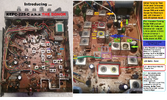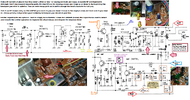There is more to this...
Then you think back to the first part of this thread, the OP didn't have issues with PA, but only TX delay.
You have RF, yes, but any simple RF power meter and a dummy load would show that.
So when you know what seems to work (Audio) because PA does work, the delay must be from other sources - so the radio has a receive and that seems to work.
Ok, the TX "seems" to work but has an audible delay in working.
One suggestion here is to see if that RF delay is from a "shift" in the TX frequency that occurs - because of it's design. The radio uses a shifted frequency of 455kHz from RX receiver IF frequency and changes to TX frequency by that 455kHz.
You'd hear this as an artifact from the "Monitor" radio tuned to listen in and is just one off in channel to the radio you're testing. (Test on 19, but listen on 20) This artifact would only occur as the radio first keys up - and would not continue to happen in later keyups - only after some delay, this might show up again.
So look thru the sections - to me I would start another re-tune process starting back at the Radios own Local Oscillator - on the 29 that's by the PLL. L22 - use R85 to view this waveform on a scope or for a simpler test, tune the radio to channel 40 - key up - with the monitor radio on 39, see if the artifact (a keyup noise even a whoosh or chirp may be heard) does appear with this method on a higher frequency channel - then repeat this process on the lowest frequency channel - Channel 1 with the Monitor listening in on Channel 2.
Other things to notice are the delay if it's shorter or non-existent - even after multiple attempts and restarts - can you recreate the condition on any extreme channel of the band - or does this effect you're having only happen on one side of channels - not other side - upper channels towards 40 or lower channel towards 1?
IF this occurs seemingly on all channels and only on the first keyups, the problem seems to be focused on TX switch and possible Mixer IC IC3. These two areas are part of the TX RF that happens when you switch the radio from RX to TX and the PLL must also shift the VCO by 455kHz to meet the 10.240 to the now ~16.xxx MHz + 455kHz signal the other half of the IF (the PLL VCO) is now showing up as output on IC3 - the TX MIXER IC as also is TOGGLED by the TX switch - it gets it's power from it to turn on.

Ok, why all the talk when you seem to have RF present - you just can't get audio at the same time? Review the 29 schematic - you have to realize other connections made to MIC jack pin 3 offer clues as to this delay.
One of them is quite direct, it's D20 part of where the RX to TX light changes - so this bi-color LED lamp shows Green, and will show RED even when TX voltage is not quite 100% where it should be.
Another area to look at and observe is D17 (RX) and D8 (TX) diodes D17 steers regulated adjustable power to the 10.240 Xtal using "Delta tune" control - but is shut off and the TX preset power is sent to the 10.240MHz Varactor diode instead, thru a preset and predetermined dropping resistor (R99 4.7K). That is if and when the TX power is "there" and RX power is shut off using Pin 3 and steering diodes (D17), the Mic Bias resistor R65 and R101 to drop RX voltage to ground and tell TR21 to turn on. The 10.240 Xtal Varactor can see a wobble in this switchover - as well as the Mic Bias quench line (a bias voltage used to put the Mic amp transistor TR17 into cut-off using R65) is also tied to D20, D15 (PLL TX 455kHz switch) and R101 and thus goes to Pin 3 TX switch ground when the Mic is keyed.
So this is not done, the delay can be for many reasons and to help isoalte it, you need to closely monitor how the RF wave is produced, for if the RX to TX switchover and 455kHz shift is taking a lot of time, some of these audio conditions you're hearing are from this contention.
It could be as simple as retweaking the L21 and L20 coils once L22 and L23 are "set" and if you can, verify that Delta Tune DOES NOT change the TX votlage - for if it does change the transmit frequecy too, this may be part of the problem




